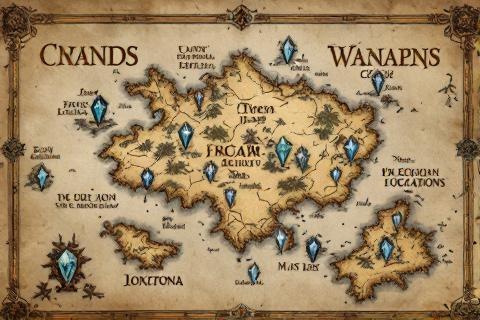
Palantíri: The Seeing-stones of Middle-earth
A Guide to the Mysterious Stones of Sight and Influence
Origins in Aman: The Creation of the Seeing-stones

The Palantíri were created in Valinor during the Years of the
Trees, when the world was still illuminated solely by
the light of the Two Trees, Telperion and Laurelin. These remarkable artifacts
emerged from the blessed realm during an age of profound enlightenment and
unprecedented craftsmanship among the Elves.
The creation of the Seeing-stones stands as one of the greatest achievements of
Fëanor, the most gifted craftsman ever born among the
Elves. The same masterful hands that created the
Silmarils also shaped these mysterious orbs, imbuing them
with properties that even the wisest of Middle-earth
never fully understood.
When the Faithful Númenóreans, led by Elendil and his sons,
fled the downfall of their island kingdom, they brought seven Palantíri to
Middle-earth as gifts from the Elves. These stones were originally presented to
the Lords of Andúnië, who remained true friends of the Elves and kept faith with
the Valar, marking them as trusted guardians of these powerful
artifacts.
Physical Properties of the Seeing-stones
The Palantíri varied dramatically in size, ranging from small spheres that could
be easily lifted to massive globes requiring great effort to move. The smallest
were approximately one foot in diameter, while the largest, such as the
Osgiliath stone, measured about three feet across.
Each Seeing-stone was crafted from an unknown crystal-like substance that
appeared black when dormant but could fill with inner fire when in use. The
material proved virtually indestructible, resisting all normal attempts at
damage or destruction, suggesting its creation involved powers beyond mortal
understanding.
The surface of each Palantír exhibited perfect smoothness, without any visible
marks, seams, or imperfections. This flawless exterior contributed to their
mysterious appearance and was integral to their function as devices of vision
and communication.
A peculiar property of the Seeing-stones was their unusual weight distribution.
As they increased in size, their weight grew at a rate far exceeding what their
dimensions would suggest, making the larger stones extraordinarily heavy and
difficult to transport without significant preparation and effort.
Powers and Capabilities

The primary function of the Palantíri allowed users to witness events occurring
at great distances, providing real-time visions of places far beyond normal
sight. These images appeared with perfect clarity within the stone's depths,
though they required careful concentration to direct and maintain.
When multiple Seeing-stones were in use simultaneously, their users could
communicate directly with one another across vast distances. This communication
manifested as both visual and mental contact, allowing the exchange of thoughts
and images between skilled practitioners separated by hundreds of miles.
The stones possessed the remarkable ability to reveal historical events that had
transpired in their immediate vicinity, though this power was limited and
required great skill to access. These glimpses into the past could provide
valuable insights but were often fragmentary and difficult to interpret
correctly.
Successfully operating a Palantír demanded exceptional mental fortitude and
extensive training. Users needed to possess both the right to use the stones and
the wisdom to direct them properly, as untrained or weak-minded individuals
risked severe consequences from improper use.
The Seven Stones of Gondor

The Osgiliath Palantír, considered the greatest and most powerful of the seven
stones brought to Middle-earth, was lost during the Kin-strife when it fell into
the Anduin River. This Master-stone had unique properties that allowed it to
oversee and coordinate the use of other stones in the network.
The stones of Minas Ithil, Minas Anor, and Orthanc formed
a crucial network across Gondor. The Ithil stone fell into
Sauron's possession when Minas Ithil became Minas
Morgul, while the Anor stone remained in the care of the
Stewards until Denethor's tragic end. The Orthanc stone, used by Saruman and
later Aragorn, survived the War of the Ring.
In the northern kingdom of Arnor, Palantíri were stationed at
Annúminas, Amon Sûl, and Elostirion. The Elostirion stone was unique as it could
only look westward across the sea to Tol Eressëa, while the others were lost
during the kingdom's dissolution and subsequent conflicts.
Proper Use and Mastery
The use of Palantíri was traditionally restricted to those of royal Númenórean
descent, as they possessed the inherent strength and authority to master the
stones. This bloodline requirement ensured that only those with the proper
heritage and training could access their power safely.
Before attempting to use a Palantír, potential users underwent rigorous
preparation and training to develop the mental discipline necessary for
controlling these powerful artifacts. This training often took years and
required guidance from experienced users who understood the stones' intricacies.
Those who attempted to use the Seeing-stones without proper preparation or
inherent strength risked severe physical and mental exhaustion. In extreme
cases, the stones could literally drain the life force from users who lacked the
necessary fortitude to control them.
Each Palantír possessed its own unique characteristics and challenges, with some
stones proving more difficult to master than others. The size of the stone often
corresponded to its power and the difficulty of its use, with larger stones
requiring greater strength of will to control effectively.
Limitations and Dangers

Despite their great power, the Palantíri had significant limitations in their
ability to see through physical obstacles. The stones could not penetrate solid
objects or pierce through areas of complete darkness, requiring a clear line of
sight to function properly.
The network of Seeing-stones operated on the principle of direct lines between
them, meaning users could only establish clear communication when an
unobstructed path existed between two stones. This limitation affected both
their communication and viewing capabilities.
Perhaps the most dangerous aspect of using the Palantíri was the risk of mental
domination by stronger users. This vulnerability became particularly apparent
during the Third Age when Sauron, controlling the Ithil stone,
could influence and deceive other users of the network.
Users of the stones faced the constant danger of receiving false or misleading
images, either through deliberate manipulation by other users or through
misinterpretation of the visions themselves. The stones showed many things, but
distinguishing truth from deception required great wisdom and discernment.
Extended use of a Palantír extracted a heavy toll on both body and mind. Users
often emerged from their sessions physically drained and mentally exhausted,
with prolonged use potentially leading to lasting damage to both physical and
mental health.
Legacy and Current Status

By the end of the Third Age, most of the Palantíri brought to Middle-earth had
been lost, destroyed, or corrupted beyond safe use. The destruction and loss of
these powerful artifacts represented a significant decline in the capabilities
and connection between the realms of Men.
Following the War of the Ring, the Orthanc stone was taken into the West aboard
the white ship that carried Elrond and the other Ring-bearers to Valinor. This
final journey of one of the last functioning Seeing-stones symbolically marked
the end of their era in Middle-earth.
The few Palantíri that might have survived into the Fourth
Age were kept hidden and unused, their locations known only to
a select few. This secrecy stemmed from the hard-learned lessons about their
potential for misuse and the dangers they posed even to worthy users.
